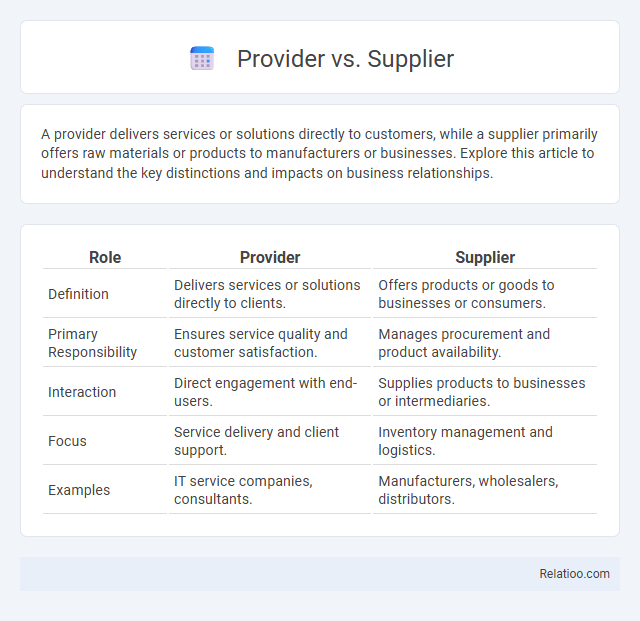A provider delivers services or solutions directly to customers, while a supplier primarily offers raw materials or products to manufacturers or businesses. Explore this article to understand the key distinctions and impacts on business relationships.
Table of Comparison
| Role | Provider | Supplier |
|---|---|---|
| Definition | Delivers services or solutions directly to clients. | Offers products or goods to businesses or consumers. |
| Primary Responsibility | Ensures service quality and customer satisfaction. | Manages procurement and product availability. |
| Interaction | Direct engagement with end-users. | Supplies products to businesses or intermediaries. |
| Focus | Service delivery and client support. | Inventory management and logistics. |
| Examples | IT service companies, consultants. | Manufacturers, wholesalers, distributors. |
Understanding the Terms: Provider vs Supplier
Understanding the terms provider and supplier is essential in business and supply chain management, as a provider typically offers services or intangible products, while a supplier delivers tangible goods or raw materials. Providers focus on meeting client needs through expertise, support, or solutions, whereas suppliers ensure the availability and timely delivery of physical items crucial for production or retail. Differentiating between these roles enhances contract clarity, resource allocation, and operational efficiency within organizations.
Key Differences Between Providers and Suppliers
Providers deliver services or expertise directly to customers, while suppliers offer physical products or raw materials for further use or resale. Your choice depends on whether you need tangible goods or specialized service solutions, as providers focus on service quality and customization, whereas suppliers emphasize product availability and logistics. Understanding these distinctions ensures you engage the right partner to meet your operational or business needs effectively.
Roles and Responsibilities: Provider vs Supplier
Providers deliver services directly to clients, managing the entire service lifecycle and ensuring quality and compliance with contractual agreements. Suppliers focus on sourcing, manufacturing, or distributing products, maintaining inventory, and managing logistics to meet client demands efficiently. Roles of providers emphasize service execution and client interaction, whereas suppliers concentrate on product availability and supply chain management.
Industry Applications: When to Use Each Term
In industry applications, use "provider" when referring to entities delivering services such as IT support, healthcare, or cloud computing, emphasizing ongoing service relationships. "Supplier" is appropriate for companies supplying tangible goods or raw materials in manufacturing, retail, or construction sectors, highlighting the transaction of products. Choose "vendor" when identifying businesses selling products or services directly to consumers or organizations, often within retail or wholesale markets.
Provider and Supplier in the Supply Chain
In the supply chain, a provider typically offers services or solutions that facilitate processes, while a supplier delivers the physical goods or raw materials needed for production. Your choice between provider and supplier depends on whether you require tangible products or specialized services to optimize operations. Understanding this distinction ensures efficient resource allocation and smooth supply chain management.
Service-Oriented Providers vs Product-Focused Suppliers
Service-oriented providers specialize in delivering customized solutions and ongoing support tailored to Your business needs, emphasizing expertise and relationship management. Product-focused suppliers concentrate on providing tangible goods or materials, prioritizing inventory, logistics, and cost efficiency. Understanding the distinction helps optimize procurement strategies by aligning service quality with product availability.
Legal and Contractual Distinctions
A provider primarily delivers services under contractual agreements, often with specific performance obligations and liability clauses outlined in service-level agreements (SLAs). A supplier typically offers goods and materials, regulated by purchase contracts that define warranties, delivery terms, and quality standards. Legal distinctions emphasize that providers assume fiduciary-like duties in service contexts, while suppliers' responsibilities center on product conformity and timely fulfillment under Uniform Commercial Code (UCC) provisions.
Impact on Business Relationships
Understanding the distinctions between provider, supplier, and vendor is crucial for optimizing your business relationships, as each role carries different expectations and engagement strategies. Providers often deliver services that require ongoing collaboration, while suppliers supply raw materials or goods essential for production, influencing reliability and inventory management. Vendors typically offer products for direct sale, impacting customer satisfaction and transactional efficiency.
Choosing Between a Provider and a Supplier
Choosing between a provider and a supplier depends on the specific needs of your business operations and the level of service required. Providers typically offer comprehensive solutions, including support and customized services, while suppliers mainly focus on delivering products or raw materials. Evaluating factors such as service scope, cost efficiency, and reliability helps determine whether a provider or supplier better aligns with your strategic goals.
Future Trends: The Evolving Roles of Providers and Suppliers
Future trends indicate a blurring of lines between providers and suppliers as digital transformation accelerates supply chain integration and service delivery models. Providers leverage advanced analytics and AI to offer personalized, value-added services beyond traditional supply functions, driving deeper customer engagement. Suppliers adopt collaborative technologies to enhance transparency, streamline operations, and support sustainability initiatives, reshaping their roles in an increasingly interconnected ecosystem.

Infographic: Provider vs Supplier
 relatioo.com
relatioo.com